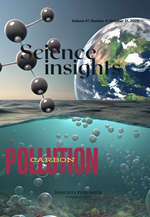Balancing the Carbon Equation: Why Direct Air Capture and Ocean Alkalinity Enhancement Must Work Together for Climate Stability?
##plugins.themes.bootstrap3.article.main##
##plugins.themes.bootstrap3.article.sidebar##
Abstract
Direct Air Capture (DAC) and Ocean Alkalinity Enhancement (OAE) are two of the most discussed ways to remove carbon dioxide from the atmosphere, each with distinctive mechanisms, strengths, and drawbacks. DAC captures CO₂ directly from ambient air via chemical or physical sorbents followed by storage or utilization, while OAE works by bolstering the ocean’s natural capacity to absorb CO₂ through increasing dissolved alkalinity, shifting inorganic carbon equilibria, and buffering pH changes. In this opinion piece I argue that neither method is sufficient alone but that together they could form a more resilient, scalable negative emissions portfolio. DAC offers precision and controllability; OAE leverages vast ocean sinks and offers co-benefits for ocean acidification, but faces challenges around environmental risks, monitoring, permanence, and scale. I call for an integrated strategy: rigorous foundational science, transparent accounting, regulatory guardrails, and public engagement. Such an approach must prioritize emissions reduction first, then deploy DAC and OAE where they are most effective, ethical, and socially acceptable.
##plugins.themes.bootstrap3.article.details##
Direct Air Capture, Ocean Alkalinity Enhancement, Carbon Dioxide Removal, Climate Change Mitigation, Negative Emissions Technologies
No funding source declared.
Barahimi, V., Ho, M., & Croiset, E. (2023). From lab to fab: Development and deployment of direct air capture of CO2. Energies, 16(17), 6385. DOI: https://doi.org/10.3390/en16176385
Bialik, O. M., Sisma-Ventura, G., Vogt-Vincent, N., Silverman, J., & Katz, T. (2022). Role of oceanic abiotic carbonate precipitation in future atmospheric CO2 regulation. Scientific Reports, 12(1), 20446. DOI: https://doi.org/10.1038/s41598-022-20446-7
Bouaboula, H., Chaouki, J., Belmabkhout, Y., & Zaabout, A. (2024). Comparative review of direct air capture technologies: From technical, commercial, economic, and environmental aspects. Chemical Engineering Journal, 484, 149411. DOI: https://doi.org/10.1016/j.cej.2024.149411
Chikamoto, M. O., DiNezio, P., & Lovenduski, N. S. (2023). Long-term slowdown of ocean carbon uptake by alkalinity dynamics. Geophysical Research Letters, 50(4), e2022GL101954. DOI: https://doi.org/10.1029/2022gl101954
Cox, E., Bellamy, R., & Waller, L. (2024). Public attitudes and emotions toward novel carbon removal methods in alternative sociotechnical scenarios. Environmental Research Letters, 19(8), 084026. DOI: https://doi.org/10.1088/1748-9326/ad5dd0
Dale, A. W., Geilert, S., Diercks, I., Fuhr, M., Perner, M., Scholz, F., & Wallmann, K. (2024). Seafloor alkalinity enhancement as a carbon dioxide removal strategy in the Baltic Sea. Communications Earth & Environment, 5(1), 1569. DOI: https://doi.org/10.1038/s43247-024-01569-3
Erans, M., Sanz-Pérez, E. S., Hanak, D. P., Clulow, Z., Reiner, D., & Mutch, G. A. (2022). Direct air capture: Process technology, techno-economic and socio-political challenges. Energy & Environmental Science, 15(4), 1360–1394. DOI: https://doi.org/10.1039/d1ee03523a
Guo, J., Strzepek, R. F., Yuan, Z., Swadling, K. M., Townsend, A. T., Achterberg, E. P., Browning, T. J., & Bach, L. T. (2025). Effects of ocean alkalinity enhancement on plankton in the Equatorial Pacific. Communications Earth & Environment, 6(1), 2248. DOI: https://doi.org/10.1038/s43247-025-02248-7
Hinrichs, C., Köhler, P., Völker, C., & Hauck, J. (2023). Alkalinity biases in CMIP6 Earth system models and implications for simulated CO2 drawdown via artificial alkalinity enhancement. Biogeosciences, 20(18), 3717–3741. DOI: https://doi.org/10.5194/bg-20-3717-2023
Honegger, M., Michaelowa, A., & Roy, J. (2020). Potential implications of carbon dioxide removal for the sustainable development goals. Climate Policy, 21(5), 678–693. DOI: https://doi.org/10.1080/14693062.2020.1843388
Lawrence, M. G., Schäfer, S., Muri, H., Scott, V., Oschlies, A., Vaughan, N. E., Boucher, O., Schmidt, H., Haywood, J., & Scheffran, J. (2018). Evaluating climate geoengineering proposals in the context of the Paris Agreement temperature goals. Nature Communications, 9(1), 3734. DOI: https://doi.org/10.1038/s41467-018-05938-3
McQueen, N., & Drennan, D. (2024). The use of warehouse automation technology for scalable and low-cost direct air capture. Frontiers in Climate, 6, 1415642. DOI: https://doi.org/10.3389/fclim.2024.1415642
Motlaghzadeh, K., Schweizer, V., Craik, N., & Moreno-Cruz, J. (2023). Key uncertainties behind global projections of direct air capture deployment. Applied Energy, 348, 121485. DOI: https://doi.org/10.1016/j.apenergy.2023.121485
Oschlies, A., Bach, L. T., Rickaby, R. E. M., Satterfield, T., Webb, R., & Gattuso, J. (2023). Climate targets, carbon dioxide removal, and the potential role of ocean alkalinity enhancement. State of the Planet, 1, oae2023–1. DOI: https://doi.org/10.5194/sp-2-oae2023-1-2023
Suitner, N., Faucher, G., Lim, C., Schneider, J., Moras, C. A., Riebesell, U., & Hartmann, J. (2024). Ocean alkalinity enhancement approaches and the predictability of runaway precipitation processes: Results of an experimental study to determine critical alkalinity ranges for safe and sustainable application scenarios. Biogeosciences, 21(20), 4587–4606. DOI: https://doi.org/10.5194/bg-21-4587-2024
Xin, X., Faucher, G., & Riebesell, U. (2024). Phytoplankton response to increased nickel in the context of ocean alkalinity enhancement. Biogeosciences, 21(3), 761–780. DOI: https://doi.org/10.5194/bg-21-761-2024

This work is licensed under a Creative Commons Attribution-NonCommercial 4.0 International License.

